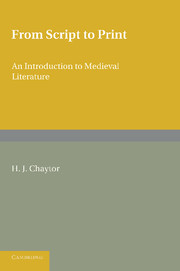Book contents
Summary
No one is likely to contest the statement that the invention of printing and the development of that art mark a turning-point in the history of civilisation. Not so readily appreciated is the fact that association with printed matter has changed our views of literary art and style, has introduced ideas concerning originality and literary property of which the age of manuscript knew little or nothing, and has modified the psychological processes by which we use words for the communication of thought. The breadth of the gulf which separates the age of manuscript from the age of print is not always, nor fully, realised by those who begin to read and criticise medieval literature. When we take up a printed edition of a medieval text, provided with an introduction, a critical apparatus of variant readings, notes and glossary, we bring unconsciously to its perusal those prejudices and prepossessions which years of association with printed matter have made habitual. We are liable to forget that we are dealing with the literature of an age when orthographical standards varied and grammatical accuracy was not highly esteemed, when language was fluid and was not necessarily regarded as a mark of nationality, when style meant the observance of fixed and complicated rules of rhetoric. To copy and circulate another man's book might be regarded as a meritorious action in the age of manuscript; in the age of print, such action results in law suits and damages. Writers who wish to derive profit by amusing a public now write for the most part in prose; until the middle of the thirteenth century, only verse could obtain a hearing. Hence, if a fair judgment is to be passed upon literary works belonging to the centuries before printing was invented, some effort must be made to realise the extent of the prejudices under which we have grown up, and to resist the involuntary demand that medieval literature must conform to our standards of taste or be regarded as of interest purely antiquarian. In the words of Renan, ‘l'essence de la critique est de savoir comprendre des états très différents de celui oÙ nous vivons’.
- Type
- Chapter
- Information
- From Script to PrintAn Introduction to Medieval Literature, pp. 1 - 4Publisher: Cambridge University PressPrint publication year: 2013



